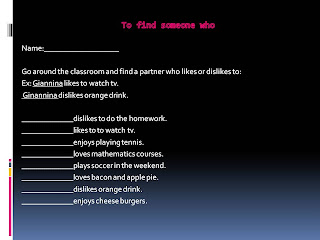Topic: Likes and Dislikes
Time alloted: 35 minutes
Level: Intermediate
Previous knowledge: Students know about likes and dislikes.
General Aim: Students will talk over about his or her preferences.
Specific Aims:
- Students will find out personal likes and dislikes with a board game activity.
- Students will exchange information about likes and dislikes with an info gap activity.
- Students will figure out whether a classmate likes or dislikes the activity in a mime game.
Procedure:
- The teacher will provide a board game related with likes and dislikes. The students will work in small groups. They will discuss about their preferences as they go further on the board game.
- The teacher will provide an info-gap activity. The task is in pairs in oder to exchange data about Carlo's preferences.
-Students will perform a mime game in front of the class individually. The students in the back will guess by loocking his or her facial expressions, movement or body gestures in order to find out the activity.
Pre - Activity:
Board Game: students will work in pairs. Each student will throw away a dice and will count the steps in the board, When you fall in a a square, the students will stay if the he or she likes according to the activity in the square. as they go all the way long throughout the game.
While - Activity
Here there are Jonathan's likes and dislikes. They are incomplete. Find the rest of his likes and dislikes with your partner. The (X) represents dislikes and the (O) reresents likes. Example:
What does Jonathan like to do on Tuesday? He likes to play bowling.
What does Jonathan dislike to eat on tuesday? He dislikes to eat fruit.

Student B

Post-Activity Likes and Dislikes mimes
What does Jonathan like to do on Tuesday? He likes to play bowling.
What does Jonathan dislike to eat on tuesday? He dislikes to eat fruit.
Student A

Student B

Post-Activity Likes and Dislikes mimes
The students will make this activity individually. The teacher will provide a mime box that keeps inside pictures with sentences like "I dislike tea" or "Ilike football". The students pick one picture up and will mime the activity in the front. The students in the back will figure out the activity by looking his expressions whether he or she likes it or not.











